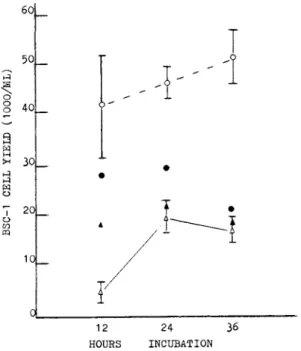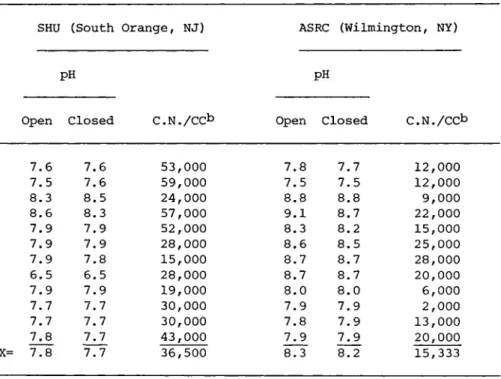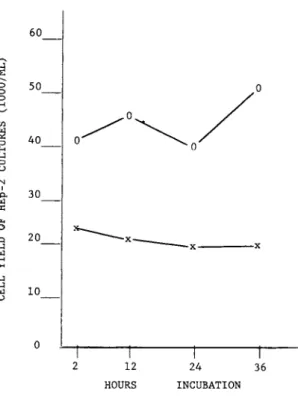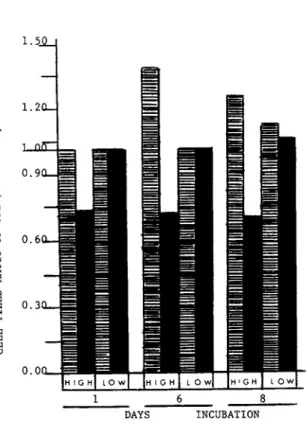FOR MONITORING AIR QUALITY
ERNEST V. ORSI PETER LEVINS GREGORY AMES LOIS BUONINCONTRI
NESTOR HOLYK RYTIS BALCIUNAS
Biology and Chemistry Departments Seton Hall University South Orange, New Jersey
I. AIR POLLUTION AND BIOLOGICAL STRESS A. The Cellular Level Approach
The response of biological systems to air pollutants has be- come an increasingly important focal point for experimentation and discussion (Ayres & Buehler, 1970, Emik et al., 1971, Coffin &
Gardner 1972, Kilburn, 1974). In contrast to the voluminous amount of information at the organism level, reports of studies utilizing cell culture systems have been few (Rhim et al., 1972, Görden et al., 1973, Roszman & Rogers, 1973). In addition these studies did not use a system in which cells replicated during continued exposure to naturally existing highly polluted urban
637
638 ERNEST V. ORSI et al.
air. Consequently a series of experiments was started employing replicate cultures from the same parent population which were taken and maintained with appropriate control procedures in re- gions of very different patterns of air quality.
II. MATERIALS AND METHODS
A. Cell Cultures 1. Cell Line
BS-C-1 (African Green Monkey, continuous, kidney) HEp-2 (Hu- man, continuous, laryngeal epidermoid carcinoma) and HEL-299 (Hu- man, diploid, embryonic lung) were obtained from the American Type Culture Collection.
2. Cell Medium
Stock cultures were grown in Eagle's Minimal Essential Medium (Eagle, 1959) in Earle's Balanced Salt Solution (Earle, 1943) supplemented with 10% heat inactivated calf serum and with each liter containing 1.9 g sodium bicarbonate, 100,000 units penicil- lin, 20 mg streptomycin, 2 mg Fungizone, and 50 mg Aureomycin.
The medium used for the "open" and "closed" test cultures was L- 15 (Leibovitz, 1963) with the same serum and antibiotic supple- ments. Both media were made from powder components from the same manufacturer and tested at the base laboratory at Seton Hall Uni- versity (SHU) before distribution under controlled conditions to other test sites. In addition, all other compounds and vessels were prepared or obtained from the base laboratory.
3. Cell Counts
Inocula were adjusted and cell yield assayed by conventional trypsinization procedures using 0.25% trypsin-saline and trypan blue exclusion for viability (Merchant et al., 1964).
Â. Atmospheric Sampling 1. Particle Counts
The small particle detector, patented by Rich of General Elec- tric (manufactured by Gardner Associates, Schenectady, Ν. Y.) was used to measure pollution in terms of condensation nuclei both in- side and outside each of the test sites. Counting was carried out with the chamber set for a minimum particle radius of 10~7 cm.
This allowed passage of some material through the bactιriologie barriers used to maintain sterility of the "open" culture vessels.
These portable instruments were checked with the continuously re- cording modules at the Atmospheric Research Center (ASRC), State University of New York (SUNY) at Albany, Wilmington, N.Y.
2. Ozone and Other Oxidants
Analysis was carried out by the "buffered alkaline" method (American Pub. Heal. Assoc., 1972). In this method a measured amount of air was drawn for 30 minutes through an impinger con- taining a 1% solution potassium iodide buffered at pH 6.8 +/- 0.2.
The iodine liberated by the oxidants was measured by the absorp- tion of triiodide ion at 352 nm.
3. Sulfur Dioxide
Analysis was carried out in a similar manner using the West- Gaeke colorimetric method (American Pub. Heal. Assoc., 1972). In this case the impingers contained potassium or sodium tetrachloro- mercurate which produced a dichlorosulfitomercurate complex. A series of stabilizing and color producing reactions followed with formation of pararosaniline methyl sulfonic acid which was mea- sured at 548 or 575 nm.
4. Barometric Pressure and Relative Humidity
At sites other than ASRC a simple continuous recorder and dial hygrometer were used respectively.
640 ERNEST V. ORSI et al.
C. General Experimental Procedure
The basic idea behind all the experiments was as follows. If the air quality differed radically in one region from another and if some of the various environmental factors could reach the cell milieu, then a cell response might occur. Published reports
(Falconer, 1970) had indicated a much greater particle count in the New York metropolitan area than the Whiteface Mountain region in Wilmington, Ν. Y. as seen in Table I. This suggested that a fairly simple procedure utilizing short term cultures involving few and relatively easily measured parameters ought to prove productive.
The two sites SHU and ASRC also differ in that the field sta- tion is about 300 miles due north at an elevation of about 2,000 feet situated among state forest in which conifers predominate.
SHU on the other hand is about 20 miles from New York City at an elevation of about 100 feet and the nearby parks consist mainly of oaks and maples. Consequently one had to consider the role of differences in gravity, barometric pressure and electromagnetic spectrum radiation in addition to vegetation.
The device of comparing differences between "open" and
"closed" cultures at each site was utilized not only to obviate most if not all ιcologie variables but also variations in cell culturing ability among participants and slight temperature vari- ations of the incubators monitored by strip chart recorders.
Additional controls were provided by starting each experiment in the following manner. Stock bottles of cells were prepared at S.H.U. as "closed" cultures. When confluency was reached, two randomly selected groups were placed in picnic coolers with frozen containers. Measurements with a recording thermometer showed that a temperature of 8.0 ± 0.5°C was maintained. The bottles in both coolers were arranged in the same manner and location not only to prevent undue chilling but also to provide uniform splashing of the medium over the cells during travel. Bottles were placed up-
TABLE I Particle Count Patterns in Urban and Rural Regions
Condensation nuclei x 103/CC
New York metro- Whiteface Mtn Month politan area Wilmington, NY
February 30.9 6.6
March 62.8 3.9
April 61.1 4.6
May 73.0 4.4
November 53.9 2.7
December 49.3 1.9
January 57.3 3.5
right with the side opposite the cells touching a thin piece of insulation next to the frozen containers. An arrow on the cooler cover indicated the same orientation of bottles in both coolers to the direction of travel in their respective vehicles. One set of cultures was taken to ASRC and the other set driven for the equivalent length of time and returned to SHU. These control trips were needed since earlier attempts to simulate travel with shakers at 4°C showed differences in both the color of the medium and the number of cells on the surface of the closed vessels of the ASRC and SHU groups.
After a convenient time of incubation at 37°C following ar- rival at the respective sites, test cultures were started in the following manner. An equal number of stock bottles were harvested at both sites and "open" and "closed" cultures started with the same number of cells in 1.0 ml in 16 x 150 mm tubes provided with solid rubber stoppers or either stoppers with cotton plugs or Morton closures. At appropriate intervals duplicate cultures from groups at each site were harvested for viable cell count.
60
12 24 36 HOURS INCUBATION
FIGURE 1 o - open cultures - SHU, · - closed cultures - SHU, Δ - open cultures - ASRC, A - closed cultures - ASRC, I - standard error.
Rate of travel, initiation of incubation after arrival, start of passage, selection of harvest intervals, and any other aspect were coordinated by telephone communication from the senior mem- ber.
III. RESULTS
Á.. Response of Continuous Cell Lines
The first series of experiments with BS-C-1 cells showed con- sistently higher yields of cells in the "open" system at SHU in contrast to the "open" cultures at ASRC. As seen in Figure 1 there was no significant difference between cultures grown in a
"closed" system at both installations. Similar results were ob- tained with HEp-2 cells. During the course of these experiments, the media in "open" cultures at SHU were noticeably more acidic than those at ASRC. Measurements of the growth medium pH at the time of cell counting seen in Table II are typical of the results
642
TABLE II Regional Air Quality and pH of Open and Closed Systemsa
Open Closed Hours incubation SHU ASRC SHU ASRC
12 7. 10 7. 37 7. 37 7. 36 7. 25 7. 40 7. 38 7. 38 7. 17 7. 39 7. 37 7. 37 24 7. 21 7. 43 7. 35 7. 35 7. 22 7. 45 7. 41 7. 40 7. 21 7. 44 7. 38 7. 37 36 7. 20 7. 35 7. 38 7. 38 7. 20 7. 48 7. 40 7. 41 7. 20 7. 42 7. 39 7. 39
apH values are of growth media of BS-C-1 cultures removed at time of cell counting.
obtained with either BS-C-1 or HEp-2 cells. The tendency for the medium to be more alakaline in regions of low particle counts was also demonstrated with media incubated in culture tubes without cells. This is shown in Table III which presents the results of an experiment in which daily particle counts and pH measurements of "open" and "closed" cultures were made at both sites for 12 days.
This evidence for medium-iatmosphere interaction prompted us to see if exposing medium to ASRC environment would produce ASRC cell yields at SHU. Replicate samples of L-15 medium capped by Morton closures were exposed to the air in a refrigerator at both sites for two weeks. No obvious volatile substances were noticed in either unit. Both units were opened and shut at least once daily, but no door opening schedule was followed. After exposure the medium at ASRC was returned to SHU and a control trip for the SHU exposed medium was carried out at the same time in the usual manner. Stock HEp-2 cultures which had been routinely propagated
TABLE III Particle Counts and pH of Growth Media Stored in Open and Closed Tubesa
SHU (South Orange, NJ) ASRC (Wilmington, NY)
pH pH Open Closed C.N./CCb Open Closed C.N./CCb
7.6 7.6 53.000 7.8 7.7 12,000
7.5 7.6 59,000 7.5 7.5 12,000
8.3 8.5 24,000 8.8 8.8 9,000
8.6 8.3 57,000 9.1 8.7 22,000
7.9 7.9 52,000 8.3 8.2 15,000
7.9 7.9 28,000 8.6 8.5 25,000
7.9 7.8 15,000 8.7 8.7 28,000
6.5 6.5 28,000 8.7 8.7 20,000
7.9 7.9 19,000 8.0 8.0 6,000
7.7 7.7 30,000 7.9 7.9 2,000
7.7 7.7 30,000 7.8 7.9 13,000
7.8 7.7 43,000 7.9 7.9 20,000
X= 7.8 7.7 36,500 8.3 8.2 15,333
apH values are of growth media incubated in tubes 1 without the use of cells. Ñ = I 0.05 that SHU open media are more acidic than ASRC; Ñ = 0.05 that SHU closed media are more acidic than ASRC;
Ñ = 0.001 that SHU particle counts are greater than ASRC.
^Particle counts of laboratory air near incubator.
at SHU provided cells for growing replicate samples of cells grow- ing in the different media but all at one location (SHU). The re- sults seen in Fig. 2 demonstrate that exposing medium to ASRC conditions produced the typical lowered cell yield but now at SHU.
B. Response of Diploid Cells
Since all our work had involved non-diploid cell lines, a series of experiments was carried out during summer, fall, and winter employing HEp-2 and HEL-299 cultures,. The WI-38, Human, diploid lung line had also been selected, but in our hands it would not grow satisfactorily in L-15 medium. Another deficiency was the fact that particle counts had been the only measurements made of pollutant levels in the areas of the incubators. The as-
644
60
2 12 24 36 HOURS INCUBATION
FIGURE 2 0 - medium exposed - SHU, X - medium exposed - ASRC. Plots are midpoints of two samples.
sumption that the indoor air quality was reflecting the known pat- terns of the region was probably valid since the interior qual-
ity will indeed often reflect that of the exterior (Schaefer et al., 1972). Nevertheless, this relation had to be verified for our specific sites.
The summer phase utilized two installations in the South Orange-Newark, N, J. area and two in the Wilmington, Ν. Y. area.
The fall and winter experiments were restricted to the Beaver-Wil and SHU locations. The same pattern was obtained regardless of the time of the year. The lowest and highest values obtained for particle counts, and S 02, and total oxidants levels adjacent to the incubators are shown in Table IV. The air quality values were obviously more similar at both regional stations than between re- gions. The Beaver-Wil highest inside count was recorded during
646 ERNEST V. ORSI et al.
TABLE IV Pattern of Condensation Nuclei Counts and Air Quality Parameters
Wilmington, N.Y.b So. Orange-Newark, N.J.C
Lowest values Beaver-Wil ASRC SHU CM & DNJ Particle count 2,100 10,300 16,000 26,000
(inside)
Particle count 1,350 2,800 66,000 56,000 (outside)a
S 02 (PPB) 0.99 1.13 7.88 15.60
(inside)
Oxidants (PPB) 8.37 4.22 8.69 9.10 (inside)
Highest values
Particle count 46,000 20,700 53,000 118,000 (inside)
Particle count 2,500 4,800 148,000 96,000 (outside)a
S 02 (PPB) 0.92 0.19 27.50 18.30 (inside)
Oxidants (PPB) 8.79 5.32 13.82 20.64 (inside)
aOutside counts were selected according to the lowest and high- est inside particle count readings for each site during a six week period.
^Beaver-Wil, private laboratory in tree farm area, el. 950 ft;
ASRC, field station, SUNY at Albany in forest, el. 2000 ft.
CSHU, Seton Hall University; CM & DNJ, College of Med. & Dent, of N.J.; five miles apart, 20 miles from N.Y.C., el. 100 ft.
construction in another part of the building, but usually these counts paralleled those at ASRC about four miles distant. It is noteworthy that a correlation between higher particle counts and increased S 02 and oxidants levels was found only in the urban area.
The HEp-2 cultures once again showed the highest cell counts in "open" systems in the region of greater air pollution. The HEL-299 cells always failed to show this since the average cell
1 6 8 DAYS INCUBATION
FIGURE 3 • HEp-2 cultures, • HEL-299 cultures, • air pol- lution levels; high = SHU, low = ASRC.
count was consistently below the average for the "closed" cul- tures in areas of higher pollution. At the lower pollution sites there was no significant difference in cell yield of HEL-299 cul- tures regardless of the system. This is demonstrated in Figure 3 which presents the ratio of "open"/"closed" cultures cell yield obtained from averages of the two sites at both regions.
IV. DISCUSSION
The ambient air measurements obtained at the four installa- tions demonstrated once again the striking extremes in air quality between the Adirondack Mountains and the New York metropolitan area. The closer values at the lower range of oxidant levels be- tween the two regions is not surprising in view of other similar
648 ERNEST V. ORSI et al.
reports (Stasiuk & Coffey, 1974). It should be pointed out that urban ozone levels are closer to those of rural regions usually during the day, and most of the air samples in our study were collected in the daytime.
The results with the cells were admittedly surprising since an inhibitory effect had been anticipated assuming any effect at all.
The fact that enhancement of continuous lines was repeated and that the media exposure experiment corrected for barometric pressure differences supported the idea that the response re- flected air quality differences. Finding that media in higher air pollution regions tended to be more acidic suggested that the higher levels of S O 2 in urban areas compensated for the tendency for media to drift particularly in an "open" system.
This is of course a possibility. Experiments still in progress utilizing water through which ambient air has been bubbled at SHU and ASRC have produced similar results as exposing complete media.
This is noteworthy since this water was then used to prepare com- plete media at SHU and utilized in "closed" systems.
Evidence that medium pH changes may not be the only mechanism involved was the selective inhibition of the diploid HEL-299 with the simultaneous enhancement of the heteroploid HEp-2 cell line.
V. SUMMARY
Controlled passages of monkey and human cell lines showed cell replication responses that reflected the air quality of the labo- ratory and the degree of exposure of the medium to the environ- ment both prior to passage and during cultivation. Heteroploid monkey and human cell line yields were enhanced in areas of higher air pollution, but a human diploid line showed inhibition
in this environment. These results indicate that continuous ex- posure of cell cultures would not only provide a suitable system
for studying cell-air toxicity mechanisms but these same cultures could serve as sensitive sentinels for air quality changes of bio- logic relevancy.
ACKNOWLEDGMENTS
We would like to express our thanks to the following individ- uals: Nesrine Baturay and Thomas Genova were most helpful in the day to day operation of the cell culture laboratory in addition to their regular biology graduate program. Thanks .are also ex- tended to Leon Pirak (SHU), Barbara Parsons (SHU), Richard Dein- inger (SUNY), Ben Novograd (SUNY) and Robert Sheridan (Upsala College, N. J.) for their participation in the summer four sites project.
The stimulating discussions with Vincent Schaefer and Raymond Falconer of the Atmospheric Sciences Dept. State University of New York at Albany as well as the courtesies extended to us at the field station have been most appreciated.
Finally a heartfelt and vigorous nod of thanks to Douglas Wolfe of the ASRC, Wilmington, Ν. Y.. for his valuable assistance ranging from introducing a biologist to weather recording instru- ments to rigging an emergency power line following a destructive bolt of lightning.
Supported in part by the Office of Naval Research #N00014-68- A-0340-0001 and National Science Foundation, Summer 1974 SOS.
REFERENCES
American Public Health Association (1972) "Methods of Air Sampl- ing and Analysis," Washington, D. C.
Ayers, S. M. and Buehler, M. E. (1970). Clin. Pharmacol. Ther. 11, 337-371.
Coffin, D. L. and Gardner, D. E. (1972). Ann. Occup. Hyg. 15, 219-
650 ERNEST V. ORSI et al.
235.
Emik, L. Ο., Plata, R. L., Campbell, Ê. I. and Clark, G. L.
(1971). Arch. Environ. Health. 23, 335-342.
Falconer, R. E. (1970). "Third Ann. Rept. of Atmos. Sei. Res.
Cen." State Univ. of New York.
Görden, R. J., Bryan, R. J., Rhim, J. S., Demoise, C., Wolford, R. G., Freeman, A. E. and Huebner, R. J. (1973). Int. J. Cancer 12, 223-232.
Kilburn, K. H., (1974). Ann. N. Y. Acad. Sei. 221, 386-390.
Merchant, D. J., Kuckler, R. J. and Munyon, W. H. (1964) "Hand- book of Cell and Organ Culture." Burgess Pub. Co., Minneapolis.
Rhim, J. S., Cho, Ç. Õ., Rabstein, L., Görden, R. J., Bryon, R.
J., Gardner, M. B. and Huebner, R. J. (1972). Nature 239, 103- 107.
Roszman, T. L. and Rogers, A. S. (1973). Ann. Rev. Resp. Dis., 108, 1158-1163.
Schaefer, V. J., Mohnen, V. A. and Veirs, V. R. (1972). Science, 175, 173-175.
Stasiuk, W. N. and Cöffey, P. E. (1974). J. Air Poll. Con. Assoc.
24, 564-568.






